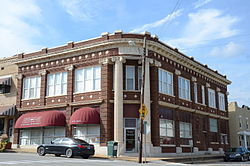United States historic place
| Heber Springs Commercial Historic District | |
| U.S. National Register of Historic Places | |
| U.S. Historic district | |
 | |
  | |
| Location | 100, 200 blocks E. Main St., 100-500 blocks of W. Main St., 100 block of N. and S. 3rd and N. and S. 4th Sts., Heber Springs, Arkansas |
|---|---|
| Coordinates | 35°29′29″N 92°1′46″W / 35.49139°N 92.02944°W / 35.49139; -92.02944 |
| Area | 31.5 acres (12.7 ha) |
| Built | 1914 (1914) |
| Architect | multiple, including Clyde A Ferrell, Charles L. Thompson, Louis A. Simon |
| Architectural style | Classical Revival, Early Commercial, Moderne |
| NRHP reference No. | 09000266 |
| Added to NRHP | May 1, 2009 |
The Heber Springs Commercial Historic District encompasses the early commercial heart of Heber Springs, Arkansas. The district extends along Main Street, between Broadway and 6th Street, including several buildings along some of the cross streets. The area was developed beginning in 1881, and grew in the late 19th and early 20th centuries, featuring a diversity of commercial architecture from that period. Prominent buildings include the Cleburne County Courthouse (1914) and the Morton Building at 101 South 3rd Street, the city's oldest surviving commercial building (1895).
The district was listed on the National Register of Historic Places in 2009. It includes several individually listed properties, including the courthouse, the T.E. Olmstead & Son Funeral Home, and the Woman's Community Club Band Shell in Spring Park.
See also
References
- ^ "National Register Information System – (#09000266)". National Register of Historic Places. National Park Service. July 9, 2010.
- ^ "NRHP nomination for Heber Springs Commercial Historic District". Arkansas Preservation. Retrieved February 27, 2016.
| U.S. National Register of Historic Places | |
|---|---|
| Topics | |
| Lists by state |
|
| Lists by insular areas | |
| Lists by associated state | |
| Other areas | |
| Related | |
This article about a property in Cleburne County, Arkansas on the National Register of Historic Places is a stub. You can help Misplaced Pages by expanding it. |